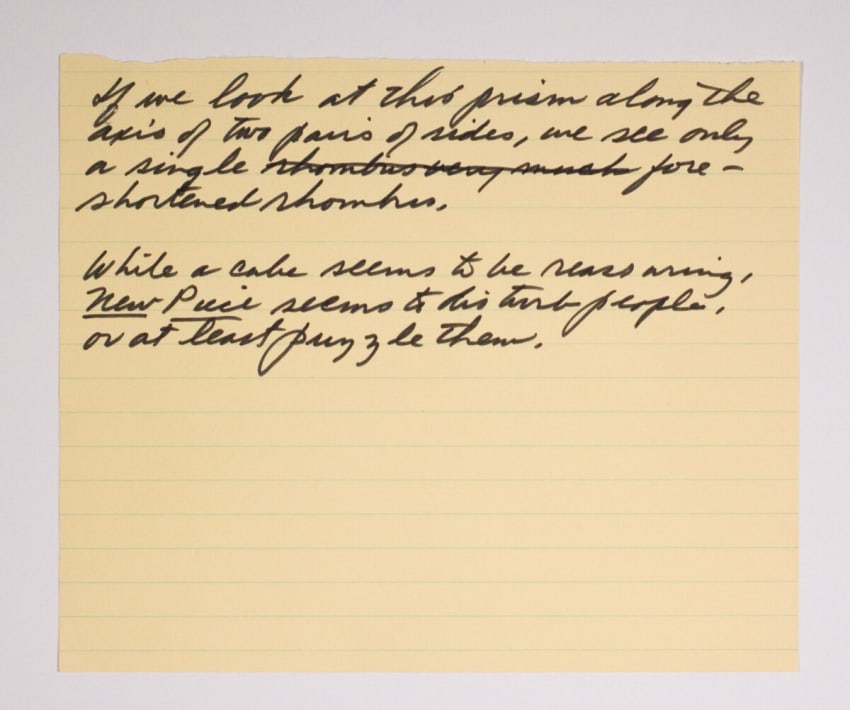Setting The Stage For Phish’s ‘Gamehendge’: The Story Of The Rhombus
Tony Smith’s sculpture, New Piece, served as the inspiration for Phish’s Gamehendge stage design at Madison Square Garden.
By Matt Hoffman Jan 12, 2024 • 1:42 pm PST

New Piece, 1966. Painted steel, 61 1" x 12' x 14'2." Institute for Advanced Study, Princeton, New Jersey, © Tony Smith Estate/Artists Rights Society (ARS), New York
While the story of The Rhombus may ultimately end in Gamehendge, it begins in suburban New Jersey. Not in Princeton, where Trey Anastasio grew up and wrote many of the songs that ultimately led to Phish’s recent spectacular New Year’s Eve show, their 83rd performance at Madison Square Garden; rather, it starts farther north in South Orange, the birthplace of sculptor Tony Smith.
In 1966, Smith created New Piece, a steel structure better known to Phish fans as “The Rhombus,” where Trey Anastasio, Tom Marshall, and their high school friends would hang out and write songs in the early 1980s. Some of these songs went on to become a part of Trey’s 1987 college thesis, a story and suite of songs entitled The Man Who Stepped Into Yesterday, more commonly known as “Gamehendge,” which in turn would go on to become some of Phish’s most popular songs.

Photo by Rene Huemer
But long before that begins the story of Tony Smith. It is a story of art history and educational reform, of geometry and patronage, and it includes cameos by Albert Einstein and Tennessee Williams.
Portrait Of The Artist
In 1912, Anthony Smith was born in South Orange, New Jersey. Smith attended a Jesuit high school in New York City and began to paint in his late teens. In his early 20s, while working for his father’s manufacturing company, he began to study drawing and painting in New York City. At 25, and against his father’s wishes, he moved to Chicago to study architecture at New Bauhaus, focused like its namesake on the relationship between design and function.
Smith left New Bauhaus after a year, spending the next two years working for Frank Lloyd Wright before commencing an 18-year career as an architect. In 1943, he married opera singer Jane Lawrence — with playwright Tennessee Williams as a witness — and lived and worked across the U.S. (and Germany, briefly) through the late 1950s. He continued to paint during this time and became close with pioneers of the abstract expressionism movement, including Jackson Pollock and Mark Rothko.

Tony Smith c. 1960s [photographer unknown], © Tony Smith Estate/Artists Rights Society (ARS), New York
Smith began making sculptures in the mid-1950s, eventually beginning to phase out his architectural work. While teaching at Bennington University in 1961, he was seriously injured in a car accident and began building small four-sided sculptures from paper during his recovery, eventually leading to the development of his best-known body of work.
In 1962, Smith worked with industrial fabricators to produce his first sculpture directly in steel, naming it Black Box. The following year, at 51 years old, his work was included in a public exhibition for the first time, and before he died in 1980, Smith went on to create over 100 sculptures, including New Piece in 1966. He became well known within the minimalist art movement, appearing on the cover of Time magazine in 1967, and was the subject of a 1998 retrospective by the Museum of Modern Art.

Advertisement
A Tribute To Einstein
Elsewhere in New Jersey, as Tony Smith’s story was unfolding in Essex County, so was the story of the Institute for Advanced Study, about 40 miles south. In 1930, educational reformer Abraham Flexner and philanthropists from the Bamberger family, who sold their profitable mid-Atlantic department store chain to Macy’s in 1929, founded the IAS in Princeton. Believing that scholars, like artists, do their best work when free from economic constraints, Flexner established the Institute to promote curiosity-driven independent inquiry in science and mathematics.
Flexner hired Albert Einstein as one of the school’s first two professors, and nearly 50 years later in 1979, IAS observed its 50th anniversary and the 100th anniversary of Albert Einstein’s birth.
Harry Woolf served as IAS director from 1976 to 1987 and facilitated an international scientific symposium in honor of this centennial, along with the installation of works of art proportional to Einstein’s contributions to science and mathematics. Smith, who taught at Princeton University from 1975 to 1977, presented the IAS with one such piece of art, New Piece, in commemoration of Einstein’s accomplishments.
Smith died of a heart attack in New York City in December 1980, and New Piece was installed in November 1981.

New Piece, 1966. Painted steel, 61 1" x 12' x 14'2." Institute for Advanced Study, Princeton, New Jersey, © Tony Smith Estate/Artists Rights Society (ARS), New York
Geometry Lesson
New Piece is technically not shaped like a rhombus. A product of Euclidian plane geometry, a rhombus is a two-dimensional parallelogram (i.e., quadrilateral with two pairs of parallel sides) with four sides of equal length. The three-dimensional equivalent is a rhombic hexahedron, a six-sided figure consisting of all rhombi, or three pairs of rhombi.
While New Piece is six-sided, each side is not a rhombus, though at least one side appears to be, based on a 1973 drawing by the fabricator, Industrial Welding. Smith describes New Piece as being made up of components of the rhomboidal dodecahedron, a three-dimensional figure consisting of all rhombi.
Rather than as a rhombic hexahedron, New Piece is technically better described as a convex hexahedron, but that doesn’t quite have the same ring as “The Rhombus” does.

© Tony Smith Estate/Artists Rights Society (ARS), New York

© Tony Smith Estate/Artists Rights Society (ARS), New York

© Tony Smith Estate/Artists Rights Society (ARS), New York
In addition to the sculpture at the IAS and the artist’s proof, which rests with Tony Smith’s Estate, Smith produced another two editions of New Piece: one resides in Houston with the Menil Collection, and the other is with a private collection. Smith also made six smaller bronze versions, as well as 40 small wooden versions produced in 1969 to benefit the Documenta Foundation.
Advertisement
Smith made other sculptures that resemble New Piece, including Wandering Rocks (1967), which includes a small hexahedron entitled Slide, and Seed (1968), which is less than half the size of New Piece.
A description of Wandering Rocks accompanying an installation at the Olympic Sculpture Park in Seattle states:
In creating Wandering Rocks, Smith, who began his career as an architect, was inspired by molecular and crystalline forms and compelled by a belief in archetypal symbolism. The sculpture’s five-part structure pays homage to the Ryōan-ji Zen garden in Kyoto, Japan.

Wandering Rocks [detail], 1967–74, Olympic Sculpture Park, Seattle
And The Rest Is History
New Piece went on to become an important part of Trey’s experience in Princeton and set the stage (literally and figuratively) for 40 years of Phish.
Sarah Auld, Director of the Tony Smith Estate, said that the estate has been aware of the Phish connection for quite a while and views the band’s New Year’s Eve set design as a tribute to the artist. MIT Press intends to publish a catalog raisonné of Tony Smith’s sculpture in fall 2024, containing his entire sculptural oeuvre of over 100 works.
Phish & Gamehendge
Advertisement
Loading tour dates



